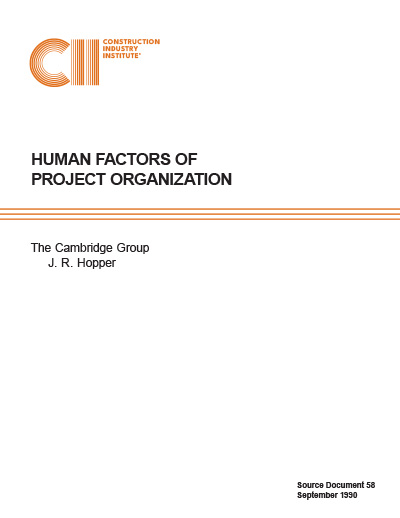
Human Factors of Project Organization
It starts the minute someone sparks the idea that something needs to be built. It ends when the last builder leaves and it is no longer a project, but a building or plant, road, bridge, or facility. At both ends and in between, there are threads, cords and rebar that tie everything together and make completion possible. The links are, of course, the human side of construction projects. If the people side is so all-pervasive, why is it that on some projects it works like a polished machine, and on others it is a constant and costly hassle: an exercise in accelerated error? We believe the answer is found in the vastly complex and distinctive arrangements of how groups and individuals array themselves on a typical construction project, i.e., how they organize teams to design and construct.
Is it possible then to predict and to repeat cost-efficient and effective human effort in construction? We firmly believe the answer is yes. Will answering the basic questions of how this is actually done improve construction and reduce costs? Again our response is yes. Many of the deeper hard-core answers to the questions are answered here.
Serious attempts at finding answers are relatively new. As an industry we did not push to even ask, until the mid-eighties. We are now forced to take notice while facing the profoundly changing issues of owner spending trends, higher costs, competition, public scrutiny, and government regulation, rising adversarial alliances, and claims. In effect, we are far behind the curve and are just now beginning the legitimate research that it takes to make consistent inroads into the knowledge base.
University engineering faculties are beginning to collect data. Research is in an early stage still. Organization specialists in the graduate business and behavioral science schools have not published any significant studies. Papers have been written, yet they are not based on actual industry data. Relying on the experiences of other industries is partially helpful, but it is essentially disarming. Such knowledge can lull us into synthetic remedies for predicting and repeating performance in construction projects.
The culture of construction requires particular attention if inroads for improving performance through organized human factors are made. Through an in-depth understanding of the life and work values of construction projects, perhaps better decisions, for example, can be made in the selection of the owner executive, owner project director/manager, owner construction manager, architect executive, and contractor project manager positions. Owners, contractors, and A and E groups alike need to revoke any past practice which give these selections anything but top priority.
Yet the culture, the “setting,” the backdrop, of construction industry behavior, has a long-standing and deeply dug-in way of handling the people side which has far deeper implications than the above example. Essentially, it values people as an extension of other component resources such as materials, equipment, time, and scheduling. It is very pragmatic, quantitative as in crewdays, man-months, yards of concrete, and tons of steel, units of productivity, and always costs-related. This is as it should be, perhaps. Yet these factors are not the whole story by any means; not even a representative portion. With the people dimension, comes motivation, leadership, adversarial intent, conflict management, communication, interpretation, power, interpersonal competency, pride, inspiration, feelings,..and quality. As an industry, we stub our toes on these essential elements of human endeavor. The course of this study is an excellent example. When we began to peel the onion and find these ingredients, and surface them, invariably discomfort set in among those who heard the reports. Oh yes, they would say, we need to treat these findings, and then quickly the issue would be changed to escape confronting the obvious. The refusal to square away and get to the core of matters may stem from the hopelessness that nothing can be done because they have tried, or because the people issues are so overwhelmingly complex. The simple fact is that we found hardly anyone who didn’t understand that there were serious problems; and no one who would address them long enough to get at them. We are dealing with a rigidly fixed paradigm in this industry hat must be changed if the people side is going to work even half again better than it is now. The biggest piece of the paradigm is failure to face up to the problems in the first place. The second is don't stir up the pot! We are wrestling with these cultural fixtures which are as heavily embedded into the surface of the earth as the foundations we build every day. Leadership is lacking to chase these issues with the pursuit required. Having said that, we will continue with the explanation of the contents of this paper.
The need for leaders plays its usual important part, but with a different slant than is found in most other industries. Managing, tied with leading, becomes a three-edged sword when added to the technical skills required. Individual companies and the industry must address changing requirements for this position and alter course to recognize its importance when designing the job and selecting people to fill it.



